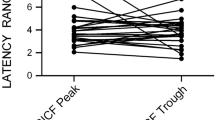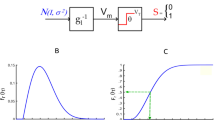Abstract
The purpose of this research was to determine whether motor cortex excitability assessed using transcranial magnetic stimulation (TMS) is less variable when subjects maintain a visually controlled low-level contraction of the muscle of interest. We also examined the dependence of single motor evoked potential (MEP) amplitude on stimulation intensity and pre-stimulus muscle activation level using linear and non-linear multiple regression analysis. Eight healthy adult subjects received single pulse TMS over the left motor cortex at a point where minimal stimulation intensity was required to produce MEPs in extensor digitorum communis (EDC). Voluntary activation of the muscle was controlled by visual display of a target force (indicated by a stable line on an oscilloscope) and the isometric force produced as the subject attempted to extend the fingers (indicated by a line on the oscilloscope representing the finger extension force) while subjects were instructed to: exert zero extension force (0%) and produce forces equal to 5 and 10% of maximum voluntary finger extension under separate conditions. Relative variability (coefficient of variation) of single MEPs at a constant stimulus intensity and of pre-stimulus muscle EMG was lower during maintained 5 and 10% contractions than at 0% contraction levels. Therefore, maintaining a stable low intensity contraction helps stabilize cortical and spinal excitability. Multiple regression analyses showed that a linear dependence of single MEPs on stimulation intensity and pre-stimulus muscle activation level produced similar fits to those for a non-linear dependence on stimulus intensity and a linear dependence on pre-stimulus EMG. Thus, a simple linear method can be used to assess dependence of single MEP amplitudes on both stimulus intensity (to characterize slope of the recruitment curve) and low intensity background muscle activation level.





Similar content being viewed by others
References
Abbruzzese G, Trompetto C, Schieppati M (1996) The excitability of the human motor cortex increases during execution and mental imagination of sequential but not repetitive finger movements. Exp Brain Res 111:465–472
Alstermark B, Isa T, Tantisira B (1991a) Integration in descending motor pathways controlling the forelimb in the cat. 18. Morphology, axonal projection and termination of collaterals from C3-C4 propriospinal neurones in the segment of origin. Exp Brain Res 84:561–568
Alstermark B, Isa T, Tantisira B (1991b) Pyramidal excitation in long propriospinal neurones in the cervical segments of the cat. Exp Brain Res 84:569–582
Amassian VE, Quirk GJ, Stewart M (1990) A comparison of corticospinal activation by magnetic coil and electrical stimulation of monkey motor cortex.[see comment]. Electroencephalogr Clin Neurophysiol 77:390–401
Butler A, Kahn S, Wolf S, Weiss P (2005) Finger extensor variability in TMS parameters among chronic stroke patients. J Neuroengineering Rehabil 2:10
Butler AJ, Yue G, Darling WG (1993) Variations in soleus H-reflexes as a function of plantarflexion torque in man. Brain Res 632:95–104
Canning CG, Ada L, O’Dwyer NJ (2000) Abnormal muscle activation characteristics associated with loss of dexterity after stroke. J Neurol Sci 176:45–56
Capaday C, Richardson MP, Rothwell JC, Brooks DJ (2000) Long-term changes of GABAergic function in the sensorimotor cortex of amputees. A combined magnetic stimulation and 11C-flumazenil PET study. Exp Brain Res 133:552–556
Capaday C, Stein RB (1987) A method for simulating the reflex output of a motoneuron pool. J Neurosci Methods 21:91–104
Cracco RQ, Amassian VE, MacCabee PJ, Cracco JB (1990) Excitatory and inhibitory effects of magnetic coil stimulation of human cortex. Electroencephalogr Clin Neurophysiol Suppl 41:134–139
Devanne H, Lavoie BA, Capaday C (1997) Input-output properties and gain changes in the human corticospinal pathway. Exp Brain Res 114:329–338
Gandevia SC, Rothwell JC (1987) Knowledge of motor commands and the recruitment of human motoneurons. Brain 110:1117–1130
Hashimoto R, Rothwell JC (1999) Dynamic changes in corticospinal excitability during motor imagery. Exp Brain Res 125:75–81
Ikai T, Findley TW, Izumi S, Hanayama K, Kim H, Daum MC, Andrews JF, Diamond BJ (1996) Reciprocal inhibition in the forearm during voluntary contraction and thinking about movement. Electromyogr Clin Neurophysiol 36:295–304
Kaelin-Lang A, Cohen LG (2000) Enhancing the quality of studies using transcranial magnetic and electrical stimulation with a new computer-controlled system. J Neurosci Methods 102:81–89
Kiers L, Cros D, Chiappa KH, Fang J (1993) Variability of motor potentials evoked by transcranial magnetic stimulation. Electroencephalogr Clin Neurophysiol 89:415–423
Lewis GN, Polych MA, Byblow WD (2004) Proposed cortical and sub-cortical contributions to the long-latency stretch reflex in the forearm. Exp Brain Res 156:72–79
Liepert J, Miltner WHR, Bauder H, Sommer M, Dettmers C, Taub E, Weiller C (1998) Motor cortex plasticity during constraint-induced movement therapy in stroke patients. Neurosci Lett 250:5–8
Magistris MR, Rosler KM, Truffert A, Myers JP (1998) Transcranial stimulation excites virtually all motor neurons supplying the target muscle. A demonstration and a method improving the study of motor evoked potentials.[see comment]. Brain 121:437–450
Mazevet D, Meunier S, Pradat-Diehl P, Marchand-Pauvert V, Pierrot-Deseilligny E (2003) Changes in propriospinally mediated excitation of upper limb motoneurons in stroke patients. Brain 126:988–1000
Niyazov DM, Butler AJ, Kadah YM, Epstein CM, Hu XP (2005) Functional magnetic resonance imaging and transcranial magnetic stimulation: effects of motor imagery, movement and coil orientation. Clin Neurophysiol 116:1601–1610
Park SW, Butler AJ, Cavalheiro V, Alberts JL, Wolf SL (2004) Changes in serial optical topography and TMS during task performance after constraint-induced movement therapy in stroke: a case study. Neurorehabil Neural Repair 18:95–105
Stinear JW, Byblow WD (2004) The contribution of cervical propriospinal premotoneurons in recovering hemiparetic stroke patients. J Clin Neurophysiol 21:426–434
Tantisira B, Alstermark B, Isa T, Kummel H, Pinter M (1996) Motoneuronal projection pattern of single C3-C4 propriospinal neurones. Can J Physiol Pharmacol 74:518–530
Thickbroom GW, Byrnes ML, Mastaglia FL (1999) A model of the effect of MEP amplitude variation on the accuracy of TMS mapping. Clin Neurophysiol 110:941–943
Tinazzi M, Zanette G (1998) Modulation of ipsilateral motor cortex in man during unimanual finger movements of different complexities. Neurosci Lett 244:121–124
Turton A, Wroe S, Trepte N, Fraser C, Lemon RN (1996) Contralateral and ipsilateral EMG responses to transcranial magnetic stimulation during recovery of arm and hand function after stroke. Electroencephalogr Clin Neurophysiol 101:316–328
Wassermann EM (2002) Variation in the response to transcranial magnetic brain stimulation in the general population. Clin Neurophysiol 113:1165–1171
Acknowledgements
Support received from the Emory University School of Medicine and the Emory Department of Rehabilitation Medicine, and NIH Grants HSD 37606 and 40984. We would also like to thank Jim Hudson for his help in the fabrication of the force measurement device. Special thanks to Charles Gibson, Jean Ko, and Amir Ahmadian, Emory Department of Rehabilitation Medicine, for assisting with recruitment of participants, data collection and analysis.
Author information
Authors and Affiliations
Corresponding author
Rights and permissions
About this article
Cite this article
Darling, W.G., Wolf, S.L. & Butler, A.J. Variability of motor potentials evoked by transcranial magnetic stimulation depends on muscle activation. Exp Brain Res 174, 376–385 (2006). https://doi.org/10.1007/s00221-006-0468-9
Received:
Accepted:
Published:
Issue Date:
DOI: https://doi.org/10.1007/s00221-006-0468-9




